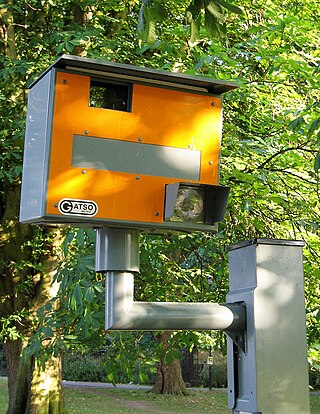
A traffic enforcement camera is a camera which may be mounted beside or over a road or installed in an enforcement vehicle to detect motoring offenses, including speeding, vehicles going through a red traffic light, vehicles going through a toll booth without paying, unauthorized use of a bus lane, or for recording vehicles inside a congestion charge area. It may be linked to an automated ticketing system.
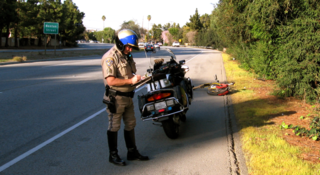
A highway patrol is a police unit, detail, or law enforcement agency created primarily for the purpose of overseeing and enforcing traffic safety compliance on roads and highways within a jurisdiction. They are also referred to in many countries as traffic police, although in other countries this term is more commonly used to refer to foot officers on point duty who control traffic at junctions.

A traffic ticket is a notice issued by a law enforcement official to a motorist or other road user, indicating that the user has violated traffic laws. Traffic tickets generally come in two forms, citing a moving violation, such as exceeding the speed limit, or a non-moving violation, such as a parking violation, with the ticket also being referred to as a parking citation, or parking ticket.

A police car is a ground vehicle used by police and law enforcement for transportation during patrols and responses to calls for service. A type of emergency vehicle, police cars are used by police officers to patrol a beat, quickly reach incident scenes, and transport and temporarily detain suspects, all while establishing a police presence and providing visible crime deterrence.

Automatic number-plate recognition is a technology that uses optical character recognition on images to read vehicle registration plates to create vehicle location data. It can use existing closed-circuit television, road-rule enforcement cameras, or cameras specifically designed for the task. ANPR is used by police forces around the world for law enforcement purposes, including checking if a vehicle is registered or licensed. It is also used for electronic toll collection on pay-per-use roads and as a method of cataloguing the movements of traffic, for example by highways agencies.

Traffic police are police officers, units, and agencies who enforce traffic laws and manage traffic. Traffic police include police who patrol highways, direct traffic, and address traffic infractions. They may be a separate agency from a main police agency, a unit or division within a police agency, or a type of assignment issued to officers; they can also be part of a transportation authority or highway authority.

VASCAR is a type of device for calculating the speed of a moving vehicle. The first VASCAR device was created in 1966 by Arthur Marshall. It is used by police officers to enforce speed limits, and may be preferred where radar or lidar is illegal, such as some jurisdictions in Pennsylvania, or to prevent detection by those with radar detectors.
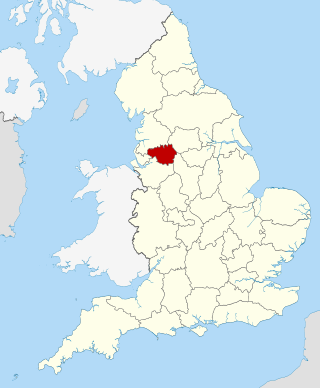
Greater Manchester Police (GMP) is the territorial police force responsible for law enforcement within the metropolitan county of Greater Manchester in North West England.

Essex Police is a territorial police force responsible for policing the county of Essex, in the East of England. Essex Police is responsible for a population of over 1.8 million people and an area of 1,420 square miles (3,700 km2).
The Traffic Operational Command Unit (OCU), formally known as CO15, was the Road Policing Unit for the Metropolitan Police Service in Greater London, England.
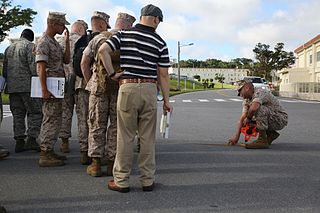
Traffic collision reconstruction is the process of investigating, analyzing, and drawing conclusions about the causes and events during a vehicle collision. Reconstructionists conduct collision analysis and reconstruction to identify the cause of a collision and contributing factors including the role of the driver(s), vehicle(s), roadway and general environment. Physics and engineering principles are the basis for these analyses and may involve the use of software for calculations and simulations. Collision reconstruction is sometimes used as the basis of expert witness testimony at trials. Collision reconstructions are performed in cases involving fatalities or personal injury. Results from collision reconstructions are also sometimes used for making roads and highways safer, as well as improving safety aspects of motor vehicle designs. Reconstructions are typically conducted by forensic engineers, specialized units in law enforcement agencies, or private consultants.
The Aviation Security Operational Command Unit (SO18), after April 2015 known as Aviation Policing Command (APC) or Specialist Operations – Aviation Policing (SOAP), is a Specialist Operations unit of London's Metropolitan Police Service. The unit is responsible for providing policing and security for both Heathrow and London City airports. London's other airports – Gatwick, Stansted and Luton – are policed by Sussex, Essex and Bedfordshire Police respectively, as they are not located in the Metropolitan Police District.
Road speed limit enforcement in Australia constitutes the actions taken by the authorities to force road users to comply with the speed limits in force on Australia's roads. Speed limit enforcement equipment such as speed cameras and other technologies such as radar and LIDAR are widely used by the authorities. In some regions, aircraft equipped with VASCAR devices are also used.

Police in the United Kingdom use a wide range of operational vehicles, including compact cars, powerful estates and armoured police carriers. The main uses are patrol, response, tactical pursuit, and public order policing. Other vehicles used by British police include motorcycles, aircraft, and boats.

Automatic number plate recognition (ANPR) is a technology for automatically reading vehicle number plates. The Home Office states ANPR is used by law enforcement agencies in the United Kingdom to help detect, deter and disrupt criminality including tackling organised crime groups and terrorists.
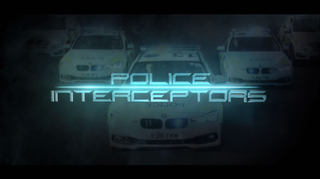
Police Interceptors is a British factual programme that profiles the work of elite police units from across the UK. There have to date been 22 series, following police units from Essex, South Yorkshire, Derbyshire, Cumbria, Lincolnshire, Durham and Cleveland, Cheshire and West Yorkshire. The current series follows the work of Nottinghamshire Police's Roads and Armed policing unit, as well as their dog unit.

National Highways traffic officers, previously Highways Agency traffic officer (HATO), are employed by the National Highways.

The National Highways & Motorway Police, abbreviated NHMP, is a police force in Pakistan that is responsible for enforcement of traffic and safety laws, security and recovery on Pakistan's National Highways and Motorway network. NHMP use SUVs, cars and heavy motorbikes for patrolling purposes and use speed cameras for enforcing speed limits.

The Garda National Roads Policing Bureau (GNRPB) (Irish: Biúró Náisiúnta an Gharda Síochána um Póilíniú Bóithre) is the roads policing unit of the Garda Síochána. Prior to 2018, it was known as the Garda Traffic Corps (Irish: Cór Tráchta an Gharda Síochána).

Speed limits are enforced on most public roadways by authorities, with the purpose to improve driver compliance with speed limits. Methods used include roadside speed traps set up and operated by the police and automated roadside 'speed camera' systems, which may incorporate the use of an automatic number plate recognition system. Traditionally, police officers used stopwatches to measure the time taken for a vehicle to cover a known distance. More recently, radar guns and automated in-vehicle systems have come into use.
















